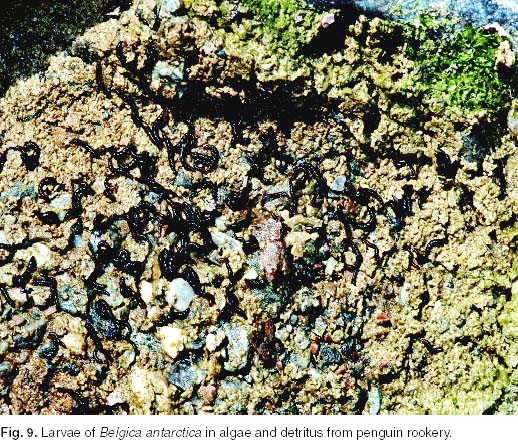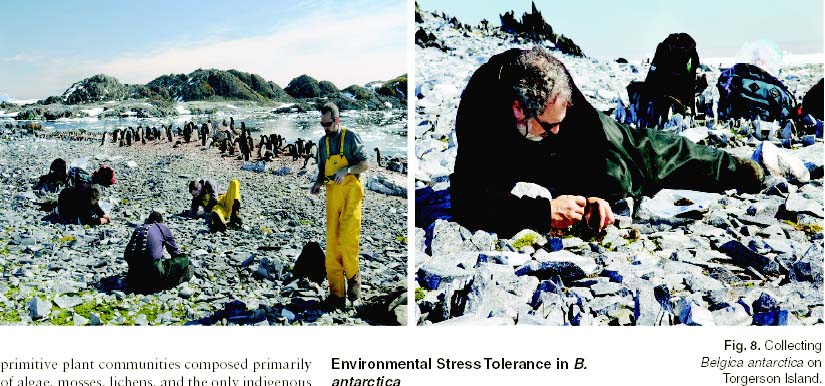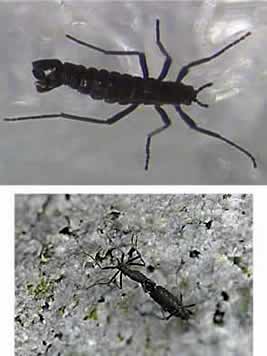Diptera.info :: Identification queries :: Diptera (adults)
Who is here? 1 guest(s)
|
Antarctic diptera
|
|
| proctoss |
Posted on 01-01-2007 23:24
|
|
Member Location: Moscow, Russia Posts: 191 Joined: 12.08.06 |
A notable addition to these terrestrial communities is the terrestrial chironomid B. antarctica, which is unique because its distribution extends farther south than any other free-living insect. Furthermore, since Antarctic vertebrates are essentially marine, it is the largest entirely terrestrial animal in the Antarctic. This endemic species is sporadically dispersed, though locally abundant at some sites, on the west coast of the ntarctic Peninsula and its islands (Fig. 8). Its ancestor is believed to have arrived 5,000?6,000 years ago from South America, where its closest relatives are found. This species is one of only two .ies occurring naturally in the Antarctic. The other species, Parochlus steinenii (Gerke), also a midge, is found on the northern tip of the Antarctic Peninsula, as well as in southern South America. This paucity of insect species stands in stark contrast to the larger and more diverse Arctic insect fauna that is dominated by Diptera, particularly Chironomidae. B. antarctica has a two-year life cycle, which includes four larval stages (Fig. 9). Overwintering may occur in any of these larval instars. Larvae feed on moss, terrestrial algae (particularly Prasiola crispa), plant and animal detritus, and microorganisms. Pupation and adult emergence occur in late spring to mid-summer. Typical of many insects living in wind-swept alpine and oceanic habitats, the adults are wingless. (Active .iers would be quickly blown out to sea in windy Antarctica.) Adult life is short: 7?10 days at most. In contrast to the male swarms of winged midges in temperate and arctic regions, the .ightless males make do with mating aggregations on the ground. Females mate within 1 day of eclosion and lay several clusters of eggs within 1?2 days . Environmental Stress Tolerance in B. antarctica Although ambient air temperature may occasionally reach winter lows of ?40 ?C on Anvers Island, B. antarctica survives freezing to only ?15 ?C, a relatively modest level of cold tolerance compared with many alpine and polar insects. Thermal buffering by snow and ice cover within its microhabitat explains this apparent anomaly; at a depth of 1 cm, substrate temperatures remain between 0 and ?2 ?C for more than 300 days of the year and rarely decrease to ?7 ?C. Thermal conditions on small islands and peninsulas are further ameliorated by the surrounding seawater, which remains between 0 ?C and ?1.8 ?C throughout the year. Unlike most temperate insects that markedly increase their cold tolerance in preparation for winter, B. Antarctica remains freeze-tolerant throughout the year. proctoss attached the following image:  [121.18Kb] Edited by proctoss on 01-01-2007 23:32 |
| proctoss |
Posted on 01-01-2007 23:38
|
|
Member Location: Moscow, Russia Posts: 191 Joined: 12.08.06 |
Collecting
proctoss attached the following image:  [106.35Kb] |
| proctoss |
Posted on 01-01-2007 23:41
|
|
Member Location: Moscow, Russia Posts: 191 Joined: 12.08.06 |
imafo
proctoss attached the following image:  [11.45Kb] |
| crex |
Posted on 02-01-2007 07:50
|
|
Member Location: Sweden Posts: 1996 Joined: 22.05.06 |
Interesting. Perhaps this should have been published as an article (on this site). |
|
|
|
| Paul Beuk |
Posted on 02-01-2007 08:47
|
|
Super Administrator Location: Netherlands Posts: 19403 Joined: 11.05.04 |
proctoss, could you please give the appropriate reference from where the images came?
Paul - - - - Paul Beuk on https://diptera.info |
| proctoss |
Posted on 05-01-2007 04:03
|
|
Member Location: Moscow, Russia Posts: 191 Joined: 12.08.06 |
Hi, link here: http://www.units.muohio.edu/cryolab/publications/documents/LeeDenlinger06_AmEnt.pdf |
| Jump to Forum: |













